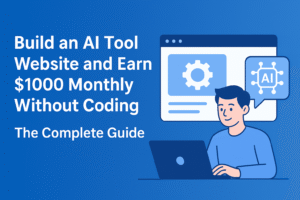The Complete Guide
The rise of AI-powered tools has opened a new door for online entrepreneurs. Every day, simple calculator-style websites and utilities are generating consistent passive income through advertising and monetization. The most exciting part? You do not need programming expertise to launch one. With the right strategy, you can build a fully functional AI tool website, drive targeted traffic, and monetize it with Google AdSense to achieve a reliable income stream.
Step 1: Identify a Profitable Low-Competition Niche
The foundation of every successful tool website is keyword research. Choosing the wrong keyword can bury your project, while a carefully selected low-competition keyword can unlock fast traffic and growth.

Using the Calculator Keyword Method
- Open a keyword research tool such as Ahrefs, SEMrush, or Ubersuggest.
- Enter a broad keyword like “Calculator” in the search field.
- Navigate to Matching Terms to find variations.
- Apply filters for Keyword Difficulty (KD) 0–10 and a minimum of 3+ words.
- Analyze the results and look for long-tail tool-based keywords such as “home loan EMI calculator” or “BMR calculator online.”
- Verify potential by searching on Google and identifying competitors with low Domain Authority but significant organic traffic.
This process allows you to target zero-competition niches where your tool can dominate search results quickly.
Step 2: Create the Tool Without Writing a Single Line of Code
Thanks to modern no-code platforms, building a tool has become simple. Platforms like Replit AI, Bubble, and AppSmith allow you to replicate and launch tools in minutes.
Building Process
- Find Inspiration: Copy the URL of an existing tool that matches your keyword research.
- AI Tool Builder: Use Replit’s AI Builder or a similar platform. Provide a clear prompt like:
“Replicate this tool’s design and functionality exactly from the following URL.”
- Plan Generation: The platform will outline required features.
- Approval & Build: Approve the plan and let the AI automatically generate the code.
- Deploy: Once finished, publish the tool on a live URL.
- Website Integration: Use iframe embedding to add the tool seamlessly into your WordPress or static site.
The result is a fully functional tool ready for users, without ever touching code.
Step 3: SEO Strategy to Rank Tool Pages on Google
Building a tool is only the first step. The real game is ranking on Google to attract traffic. A targeted SEO approach ensures long-term growth.
1. Semantic SEO & Topical Authority
- Don’t stop at optimizing only for the main keyword.
- Build content clusters around the topic. For instance, if your tool is a Loan Calculator, publish supporting content such as:
- “Different Types of Loans Explained”
- “How Interest Rates Impact Loan Repayments”
- “Top Financial Planning Tips for Borrowers”
- Use NLP keywords (Google’s natural language processing terms) to strengthen topical relevance.
2. On-Page SEO Perfection
- Meta Title: Include your primary keyword within the first 60 characters.
- Meta Description: Write a compelling description that integrates the keyword naturally.
- H1-H3 Hierarchy: Use heading tags strategically for readability and SEO strength.
- Internal Linking: Link your tool page to blog posts and vice versa.
- Alt Text Optimization: Every image must have descriptive alt text containing keywords.
3. Backlink Building Strategy
High-quality backlinks elevate your authority. Target:
- Guest Posts: Publish on financial, educational, or niche-related blogs.
- Resource Pages: Submit your tool to online directories and “useful tools” lists.
- Quora & Reddit: Share your tool as a solution in relevant discussions.
- Anchor Text Variety: Use exact-match, branded, and generic anchors for a natural profile.
Step 4: Monetize with Google AdSense
The next phase is converting traffic into steady income through Google AdSense approval.
1. Prepare Your Website for Approval
Google evaluates websites on structure and trustworthiness. Ensure:
- A mobile-friendly, lightweight theme with fast load speed.
- SSL certificate (HTTPS) for security.
- No “under construction” pages or broken links.
- Clear and clean navigation for the user experience.
2. Essential Pages for AdSense
Your site must include:
- About Us: Who you are and what you offer.
- Contact Us: Multiple ways to reach you (form, email, social links).
- Privacy Policy: Transparent data handling policy.
- Terms & Conditions: Rules for using your tool.
- Disclaimer: Clarify tool limitations (important for financial/health tools).
3. Add High-Quality Blog Posts
Even if your site is tool-focused, Google requires content depth. Publish at least 10–15 unique blog posts before applying for AdSense.
- Word Count: 800–1200 words per post.
- Topic Relevance: Articles related to your tool (e.g., loan tips, calorie tracking, unit conversions).
- Originality: No plagiarism; AI-generated content should be edited for human tone.
This content will strengthen your site’s authority, improve ranking, and meet Google’s quality guidelines.
Step 5: Scaling Your Income Beyond $1000/Month
Once approved for AdSense, focus on scaling traffic and exploring additional revenue streams.
- Affiliate Marketing: Add affiliate links related to your niche (loans, diet programs, software tools).
- Sponsored Posts: Monetize guest contributions once your site grows authority.
- Multiple Tools: Launch 2–3 related tools under the same domain to multiply traffic.
- Email List Building: Offer free downloads or calculators to grow an email audience for long-term monetization.
Conclusion
Building a tool-based AI website without coding is one of the most efficient ways to earn a consistent, passive online income. By carefully researching a low-competition niche, using AI to replicate and deploy the tool, optimizing for SEO, and following the proven AdSense approval formula, you can achieve steady monthly revenue. Over time, scaling with multiple tools and diversifying monetization can significantly increase your earnings, potentially pushing them far beyond $1000 per month.
